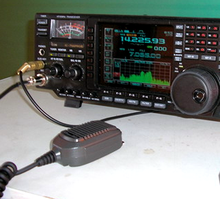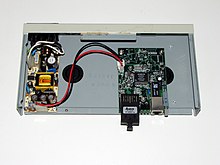Transceiver
This article includes alist of references,related reading,orexternal links,but its sources remain unclear because it lacksinline citations.(August 2020) |
Inradio communication,atransceiveris an electronic device which is a combination of a radiotransmitterand areceiver,hence the name. It can both transmit and receiveradio wavesusing anantenna,for communication purposes. These two related functions are often combined in a single device to reduce manufacturing costs. The term is also used for other devices which can both transmit and receive through acommunications channel,such asoptical transceiverswhich transmit and receive light inoptical fibersystems, andbus transceiverswhich transmit and receivedigital datain computerdata buses.
Radio transceivers are widely used inwireless devices.One large use is intwo-way radios,which areaudiotransceivers used for bidirectional person-to-person voice communication. Examples arecell phones,which transmit and receive the two sides of a phone conversation using radio waves to acell tower,cordless phonesin which both the phone handset and the base station have transceivers to communicate both sides of the conversation, andland mobile radio systemslikewalkie-talkiesandCB radios.Another large use is inwireless modemsin mobile networked computer devices suchlaptops,pads, and cellphones, which both transmit digital data to and receive data from awireless router.Aircraft carry automatedmicrowavetransceivers calledtransponderswhich, when they are triggered by microwaves from anair traffic control radar,transmit a coded signal back to the radar to identify the aircraft. Satellite transponders incommunication satellitesreceive digital telecommunication data from asatellite ground station,and retransmit it to another ground station.
History
[edit]
The transceiver first appeared in the 1920s.[citation needed]Before then, receivers and transmitters were manufactured separately and devices that wanted to receive and transmit data required both components. Almost all amateur radio equipment today[when?]uses transceivers, but there is an active market for pure radio receivers, which are mainly used byshortwave listeningoperators.[citation needed]
Analog
[edit]Analog transceivers usefrequency modulationto send and receive data. Although this technique limits the complexity of the data that can be broadcast, analog transceivers operate very reliably and are used in many emergency communication systems. They are also cheaper than digital transceivers, which makes them popular with theCBandHAM radiocommunities.
Digital
[edit]Digital transceivers send and receivebinary dataover radio waves. This allows more types of data to be broadcast, including video and encrypted communication, which is commonly used by police and fire departments. Digital transmissions tend to be clearer and more detailed than their analog counterparts. Many modern wireless devices operate on digital transmissions.
Usage
[edit]Telephony
[edit]
In a wiredtelephone,the handset contains the transmitter (for speaking) and receiver (for listening). Despite being able to transmit and receive data, the whole unit is colloquially referred to as a "receiver". On amobile telephoneor otherradiotelephone,the entire unit is a transceiver for both audio and radio.
Acordless telephoneuses an audio and radio transceiver for the handset, and a radio transceiver for thebase station.If aspeakerphoneis included in a wired telephone base or in a cordless base station, the base also becomes an audio transceiver.
Amodemis similar to a transceiver in that it sends and receives a signal, but a modem uses modulation and demodulation. It modulates the signal being transmitted and demodulates the signal being received.
Ethernet
[edit]
Transceivers are calledMediumAttachment Units (MAUs) inIEEE 802.3documents and were widely used in10BASE2and10BASE5Ethernetnetworks.Fiber-opticgigabit,10 Gigabit Ethernet,40 Gigabit Ethernet,and100 Gigabit EthernetutilizeGBIC,SFP,SFP+,QSFP,XFP,XAUI,CXP,andCFPtransceiver systems.
Regulation
[edit]Because transceivers are capable of broadcasting information over airwaves, they are required to adhere to various regulations. In the United States, theFederal Communications Commissionoversees their use. Transceivers must meet certain standards and capabilities depending on their intended use, and manufacturers must comply with these requirements. However, transceivers can be modified by users to violate FCC regulations. For instance, they might be used to broadcast on a frequency or channel that they should not have access to. For this reason, the FCC monitors not only the production but also the use of these devices.
See also
[edit]- Two-way radio
- 4P4C,de facto standardconnectorfor telephone handsets
- Duplex,two-way communications capability
- Radar beacon
- Transmitter
- Radio transmitter design
- Radio receiver
- Radio receiver design
- Transponder
References
[edit]- Rutledge, D. (1999).The electronics of radio.Cambridge [England]; New York: Cambridge University Press.
- Reinhart, R. C. K. (2004).Reconfigurable transceiver and software-defined radio architecture and technology evaluated for NASA space communications.https://ntrs.nasa.gov/search.jsp?R=20050215177
- Govinfo.(n.d.). Retrieved February 29, 2020, from https://www.govinfo.gov/app/details/CFR-2010-title47-vol1/CFR-2010-title47-vol1-sec2-926
- Haring, K. (2007).Ham radio's technical culture(Inside technology). Cambridge, Mass.: MIT Press.
 This article incorporatespublic domain materialfromFederal Standard 1037C.General Services Administration.Archived fromthe originalon 2022-01-22.(in support ofMIL-STD-188).
This article incorporatespublic domain materialfromFederal Standard 1037C.General Services Administration.Archived fromthe originalon 2022-01-22.(in support ofMIL-STD-188).
External articles
[edit]- U.S. patent 0,716,136,John Stone Stone,"Apparatus for simultaneously transmitting and receiving space telegraph signals"
- 7 MHz SSB transceiver
